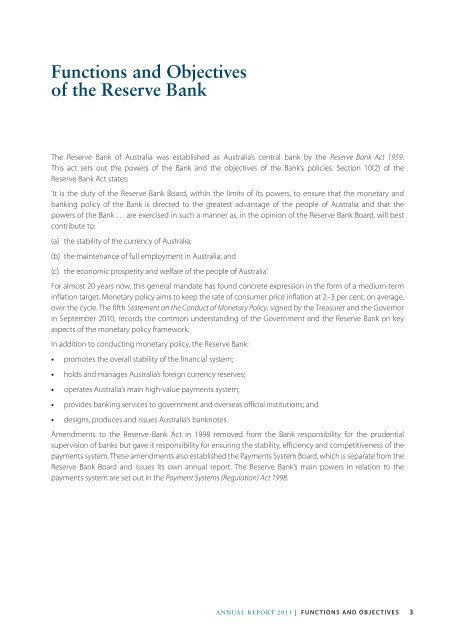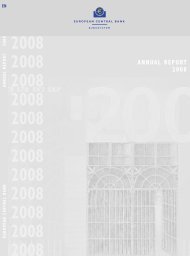Reserve Bank of Australia Annual Report 2011
Reserve Bank of Australia Annual Report 2011
Reserve Bank of Australia Annual Report 2011
You also want an ePaper? Increase the reach of your titles
YUMPU automatically turns print PDFs into web optimized ePapers that Google loves.
Functions and Objectives<br />
<strong>of</strong> the <strong>Reserve</strong> <strong>Bank</strong><br />
The <strong>Reserve</strong> <strong>Bank</strong> <strong>of</strong> <strong>Australia</strong> was established as <strong>Australia</strong>’s central bank by the <strong>Reserve</strong> <strong>Bank</strong> Act 1959.<br />
This act sets out the powers <strong>of</strong> the <strong>Bank</strong> and the objectives <strong>of</strong> the <strong>Bank</strong>’s policies. Section 10(2) <strong>of</strong> the<br />
<strong>Reserve</strong> <strong>Bank</strong> Act states:<br />
‘It is the duty <strong>of</strong> the <strong>Reserve</strong> <strong>Bank</strong> Board, within the limits <strong>of</strong> its powers, to ensure that the monetary and<br />
banking policy <strong>of</strong> the <strong>Bank</strong> is directed to the greatest advantage <strong>of</strong> the people <strong>of</strong> <strong>Australia</strong> and that the<br />
powers <strong>of</strong> the <strong>Bank</strong> … are exercised in such a manner as, in the opinion <strong>of</strong> the <strong>Reserve</strong> <strong>Bank</strong> Board, will best<br />
contribute to:<br />
(a) the stability <strong>of</strong> the currency <strong>of</strong> <strong>Australia</strong>;<br />
(b) the maintenance <strong>of</strong> full employment in <strong>Australia</strong>; and<br />
(c) the economic prosperity and welfare <strong>of</strong> the people <strong>of</strong> <strong>Australia</strong>.’<br />
For almost 20 years now, this general mandate has found concrete expression in the form <strong>of</strong> a medium-term<br />
inflation target. Monetary policy aims to keep the rate <strong>of</strong> consumer price inflation at 2–3 per cent, on average,<br />
over the cycle. The fifth Statement on the Conduct <strong>of</strong> Monetary Policy, signed by the Treasurer and the Governor<br />
in September 2010, records the common understanding <strong>of</strong> the Government and the <strong>Reserve</strong> <strong>Bank</strong> on key<br />
aspects <strong>of</strong> the monetary policy framework.<br />
In addition to conducting monetary policy, the <strong>Reserve</strong> <strong>Bank</strong>:<br />
••<br />
promotes the overall stability <strong>of</strong> the financial system;<br />
••<br />
holds and manages <strong>Australia</strong>’s foreign currency reserves;<br />
••<br />
operates <strong>Australia</strong>’s main high-value payments system;<br />
••<br />
provides banking services to government and overseas <strong>of</strong>ficial institutions; and<br />
••<br />
designs, produces and issues <strong>Australia</strong>’s banknotes.<br />
Amendments to the <strong>Reserve</strong> <strong>Bank</strong> Act in 1998 removed from the <strong>Bank</strong> responsibility for the prudential<br />
supervision <strong>of</strong> banks but gave it responsibility for ensuring the stability, efficiency and competitiveness <strong>of</strong> the<br />
payments system. These amendments also established the Payments System Board, which is separate from the<br />
<strong>Reserve</strong> <strong>Bank</strong> Board and issues its own annual report. The <strong>Reserve</strong> <strong>Bank</strong>’s main powers in relation to the<br />
payments system are set out in the Payment Systems (Regulation) Act 1998.<br />
ANNUAL REPORT <strong>2011</strong> | Functions and Objectives<br />
3





![KNOW YOUR NEW GIBRALTAR BANKNOTES - [Home] bThe/b](https://img.yumpu.com/50890985/1/184x260/know-your-new-gibraltar-banknotes-home-bthe-b.jpg?quality=85)
![PAPUA NEW GUINEA - [Home] - Polymer Bank Notes of the World](https://img.yumpu.com/49758743/1/190x143/papua-new-guinea-home-polymer-bank-notes-of-the-world.jpg?quality=85)










